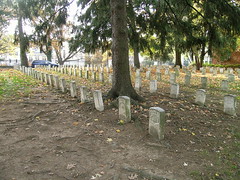By Erin Carlson Mast
 In 2004, President Lincoln’s Cottage formed a partnership with high school history teacher Paul LaRue of the Washington Senior High School in Washington Court House, Ohio. LaRue’s Research History students had recently completed an extensive research project on an historic Ohio cemetery, and were looking for a new project. Staff members at the Cottage were interested in finding out more about the adjacent U.S. Soldiers’ and Airmen’s Home National Cemetery, which saw thousands of Civil War burials between 1861 to 1864, less than 200 yards from President Lincoln’s Cottage, while Lincoln was living at the Soldiers’ Home and walking the grounds.
In 2004, President Lincoln’s Cottage formed a partnership with high school history teacher Paul LaRue of the Washington Senior High School in Washington Court House, Ohio. LaRue’s Research History students had recently completed an extensive research project on an historic Ohio cemetery, and were looking for a new project. Staff members at the Cottage were interested in finding out more about the adjacent U.S. Soldiers’ and Airmen’s Home National Cemetery, which saw thousands of Civil War burials between 1861 to 1864, less than 200 yards from President Lincoln’s Cottage, while Lincoln was living at the Soldiers’ Home and walking the grounds.
The staff at the Cottage received a transcription of all the people buried in the cemetery from Beryl Smith, a resident of the Armed Forces Retirement Home, but initial searches did not turn up additional information on the cemetery. LaRue’s students cross referenced the transcriptions with the Roll of Honor and the Dept. of Veterans Affairs Nationwide Gravesite Locator. The resulting data provides an invaluable resource to President Lincoln’s Cottage, and answers a variety of questions. For example, the students’ research revealed that during Lincoln’s first season at the Soldiers’ Home 1,255 burials took place in the cemetery, an average of more than 8 per day, within view of his summer residence.
Download the spreadsheet and analysis sheets here:
CW Burials at USSAH National Cemetery.pdf
CW Burials by State and Regiment.pdf
Formerly part of the “Soldiers Home” (now known as the Armed Forces Retirement Home) the USSAH National Cemetery is the first national cemetery and is the predecessor of Arlington National Cemetery. Today the USSAH National Cemetery is run by Arlington and is accessed through a gate off of Harewood Road in northwest Washington, D.C.
For more on how Paul LaRue combines preservation and education, read his latest blog entry: Take Your Seats: Welcome to Teaching Preservation
Special thanks to the students of Mr. Paul LaRue’s 2004/2005 and 2005/2006 American History and Research History classes.